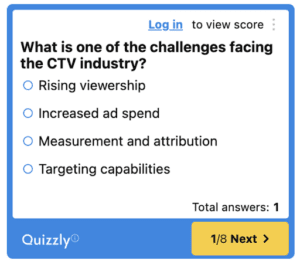
A Q&A with Ravi Mittal, Founder and CEO of Vuukle, on how publishers can leverage quizzes to build audiences, collect first-party data, and drive engagement.
The demise of the third-party cookie once sent waves of fear through the digital advertising ecosystem, but not anymore. That’s because, in the years that followed Google’s original cookie deprecation announcement, the industry has been hard at work innovating new ways for publishers to segment their audiences so that their advertising partners can target them.
For Ravi Mittal, Founder and CEO of Vuukle, the most obvious way to get highly valuable data, including purchase intent and sentiment, is for publishers to ask them. Recently he launched Quizzly.ai — a tool that is part quiz and part game that early tests show readers are eager to use.
We talked with Ravi about how tools like quizzes can fit into the publisher’s and advertiser’s strategies.
AdMonsters: Vuukle recently announced Quizzly.ai. What is that exactly?
RM: It’s an AI-driven quiz that publishers easily embed in their sites using JavaScript. Then the code extracts the content of the page, whether that’s text or images, and sends it to a quiz AI engine. The engine looks at the content and turns the interesting bits into a question-and-answer format.
 So take the AdMonsters article on the 10 Commandments of CTV. The chart to the left is the first question of an eight-question quiz that the tool created in real-time.
So take the AdMonsters article on the 10 Commandments of CTV. The chart to the left is the first question of an eight-question quiz that the tool created in real-time.
These quizzes appear at the bottom of the article, which encourages the user to test their understanding of what they just read. The quiz tells the reader whether they’ve answered correctly or incorrectly.
It’s a great way to increase engagement with the publisher’s content.
AdMonsters: Can the tool understand video content as well?
RM: We’re working on it. Soon.
AdMonsters: Does the tool ask the users’ opinion of what they just read, or are the questions about the content itself?
RM: We trained the AI model to pick out specific types of sentences, which enables it to create quizzes on the fly.
AdMonsters: I can see how it would prompt more engagement for people who take the quiz, but how many actually do that?
RM: That’s a great question. We asked ourselves the same question after we built the quiz unit but hadn’t launched it as an official product. But we tested it, and based on the data, it seems people have a natural tendency to test themselves. Without any incentive whatsoever, we’re seeing 8 to 10% user engagement rates for the quizzes.
AdMonsters: How can publishers turn that 8 to 10% engagement into audiences for segmentation and targeting purposes?
RM: Excellent question. There are a few ways to do that. First, we can create quizzes that include sponsored comments that ask about brand preferences, products, brand recall, or any number of things. Those sponsored questions come after the first two questions that are based on the article content itself.
As an example, we recently worked with an electronics manufacturer that was keen to do a brand measurement study. The sponsored question asked about a product or product category of interest. When users answered the question it provided the brand with the information it wanted, but it also informed the publisher about the types of content of interest to their readers. This allowed the publisher to create a unique audience segment they could offer to their advertisers.
AdMonsters: Don’t brands typically hire a comScore or Nielsen to get that data?
RM: Yes, it’s an $80 billion market. Now publishers can get in on it, and tap into a new revenue stream.
AdMonsters. That’s great. What’s the other way for publishers to build their first-party data set?
RM: Another way to collect first-party data is to ask questions that are relatively generic but are tied to IAB categories, such as, “How often do you visit local attractions.” The user responses are stored in the publisher’s GAM or Google Ad Manager. Later on, if a brand wants to target audiences to visit a local attraction, the publisher has a segment of users who answered the question, “frequently” or “monthly.”
These questions provide an opportunity for publishers to ask users questions and record their preferences as definitive purchase intent. It’s deterministic, not probabilistic data.
AdMonsters: So it’s always building audience segments with those generic questions, even if they aren’t sponsored?
RM: Yes, and those questions can be very specific about purchase intent. Are you planning to move in the next six months, or renovate your kitchen, or purchase a new car?
These questions provide an opportunity for publishers to ask users questions and record their preferences as definitive purchase intent. It’s deterministic, not probabilistic data.
AdMonsters: That sounds like a real selling point for the publisher who wants to sell premium audience segments based on purchase intent.
RM: It is a benefit because it’s based on real data that came directly from the users, rather than the guesswork of an SSP or DSP that segments users based on a handful of online behaviors.
Publishers can use the data they collect, to build segments, which they can offer to brands as highly qualified audiences.
AdMonsters: And at higher CPMs because they’re more premium and more unique. But of the 8 to 10% response rate of the people who take the quizzes actually answer those market research and sponsored questions?
RM: We’re seeing about a 40% completion rate. One of the reasons why we get a high response rate in the quizzes themselves and the sponsored questions is we’ve gamified it. Users who take the quizzes in their entirety have the opportunity to participate in a leaderboard.
The leaderboard also drives engagement, page views, and revenue. The more questions the reader answers correctly, the higher they’ll be on the leaderboard. This provides an incentive for readers to refer back to the article prior to answering questions. That’s good for them, and it’s good for the publisher.
AdMonsters: Leaderboards certainly provide an incentive to people who like to play online games. What is your recommendation for deploying these quizzes? Are there some sections or topics that perform better than others?
RM: That’s an interesting question. In the past, quizzes haven’t been major drivers of engagement because the onus was on the publisher to create and deploy them. But when you can automate the process and create quizzes on the fly, things get really interesting. Suddenly it becomes possible to create a quiz for every article and have them embedded on every page.
We recommend quizzes for every article published, even sponsored articles, as each quiz is an opportunity for the publisher to collect data and create really unique audiences.
AdMonsters: I can see why that makes sense for a sponsored article, but does it make sense for The New York Times to have a quiz on every article? I would think the users would stop seeing them after a while.
RM: I agree with you to a degree. There are some topics, say war or crime, where you wouldn’t want a quiz, and especially a quiz with sponsored content. But we can suppress quizzes based on the sentiment of the article.
There are some topics, like sports and politics, that are highly conducive to these quizzes because there are a lot of stats and trivia and people like testing their knowledge. Politics and sports consistently get 10% or higher engagement rates. Articles on relationships see even higher engagement with the quizzes.
AdMonsters: Speaking of politics, next year we will see $10 billion in political ads. People are very wary of generative AI and disinformation. What do you say to publishers who worry about AI-generated quizzes?
RM: That’s a fair question. There are many types of AI, and we’ve chosen a strategy that is risk-averse. We’re using content that is contained in an article itself and has been vetted by the editorial staff. We’re not using generative AI to create new text, and that’s an important distinction. We’re telling people that to get high on the leaderboard, they need to refer back to the vetted content in the article.
AdMonsters: So in addition to boosting engagement and dwell time, the publisher is improving reader comprehension?
RM: That’s right.
Ravi Mittal, Founder and CEO – Vuukle/Quizzly
Ravi Mittal is a highly accomplished entrepreneur and technology enthusiast with a strong background in Information Systems Engineering. He graduated from Imperial College London and quickly jumped into the corporate world, beginning his career at the prestigious Goldman Sachs.
In 2012, Ravi founded Vuukle, a revolutionary commenting platform that has since become one of the largest in the world. This innovative platform is utilized by over 500 websites across the globe, transforming the way users engage and interact with online content. Under Ravi’s leadership, Vuukle has expanded its offerings to include a range of cutting-edge products such as social share bars, reactions, push notifications, real-time analytics, and Quizzly.ai.
With over a decade of experience in adtech, Ravi has become a recognized expert in the field. He has closely worked with SSPs, DSPs, and publishers, gaining valuable insights into the complexities of the digital advertising ecosystem.